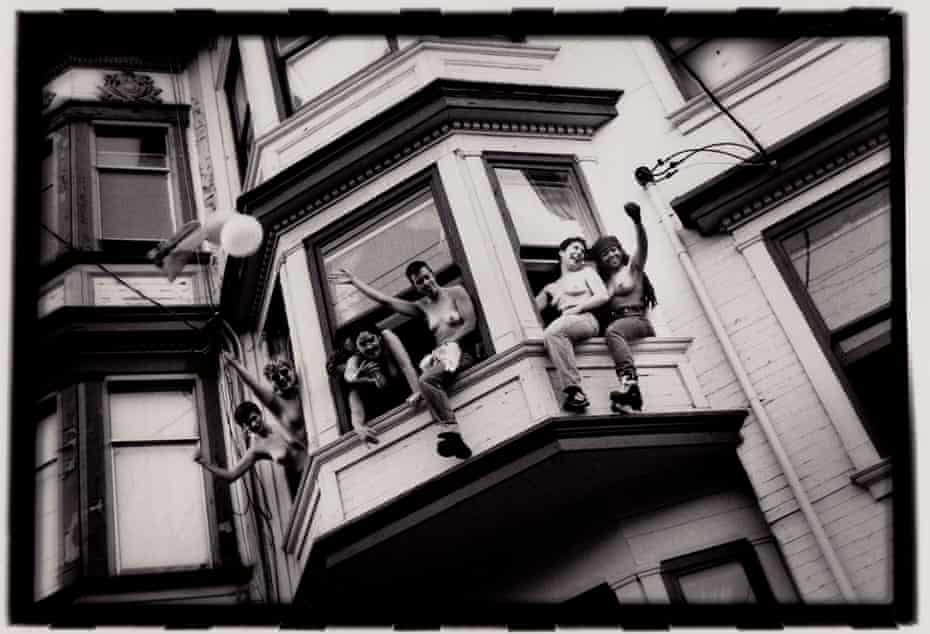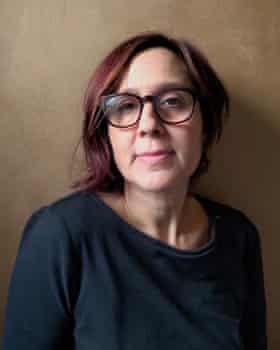‘The march is like our Christmas – the biggest night of the year, where women celebrate half naked and anything goes’

Shirtless statement … Dyke March, 1999, by Phyllis Christopher.
Photograph: Phyllis Christopher
Interview by Edward Siddons
Wed 12 Jan 2022
In San Francisco, the night before the annual Pride parade is reserved for the Dyke March, a celebration of lesbian life throughout the city. It was like our Christmas – the biggest night of the year – and half of us would be so hungover we wouldn’t make it to Pride the next day.
I remember getting a call from an editor at On Our Backs, a lesbian magazine run by women that billed itself as offering “entertainment for the adventurous lesbian”. It was a bedrock of the lesbian community – one of the few ways to communicate with one another, and to celebrate sex and educate each other about it at a time when Aids had brought so much devastation to queer communities. The editor wanted me to shoot a kiss-in, but the tone of her voice sounded almost guilty – like she couldn’t quite bring herself to ask me to work on the biggest party night of the year. But to me, it was the most fun I could imagine
Lesbians from all over the country, many of whom I knew, had gathered in the park, mingling and chatting to whoever came along – gay, straight, whatever gender. But when the Dyke March began, the crowds cleared and the Dykes on Bikes took the lead, with the rest of us forming a column behind.
I’ve always found something beautiful about that moment: people stepping aside to give lesbians their space, to celebrate and applaud them. Many of the women would march shirtless as a gesture of their freedom. It was a time for lesbians to assert themselves in the public sphere, a moment of safety and joy.
It was a way of celebrating sex in the face of the death wrought by Aids – and opposing those who blamed us for it
The rules of the Dyke March were pretty much “anything goes as long as it’s fun”. Women were celebrating being half naked, feeling safe and supported by everyone. There were no protesters because there were simply too many queer people in San Francisco. It was a moment of wild abandon, marching through the streets, climbing bus stops, on top of cars, hanging out of windows.
This shot was taken on 18th Street in the Castro, one of the centres of queer life in San Francisco. Anyone who had an apartment on the march route would take full advantage of their windows. Every year, the inhabitants of houses would lean out of the windows, often with signs, screaming for the crowd and the crowd would scream back.
More than 20 years later, this image still hits me in my gut: I feel the power in it. It encapsulates a kind of joy that, at the time, was absolutely necessary. It was a way of celebrating sex in the face of the death wrought by Aids, and in opposition to voices on the right who blamed us for the epidemic. We couldn’t marry and job security was still uneven across the US for queer people. We still felt like outlaws
In the 1980s, there was a lot of discussion among feminists about the importance of sex. Some took a strident line – that photographing sex was offensive, even violent. While we owe everything to lesbian feminists of that era – they paved the way in so many respects – our generation wanted something different. We were pro kink, pro sex, and pro pornography. Sex meant a lot to us; we weren’t just going to let it go. It was a kind of political hedonism.
Interview by Edward Siddons
Wed 12 Jan 2022
In San Francisco, the night before the annual Pride parade is reserved for the Dyke March, a celebration of lesbian life throughout the city. It was like our Christmas – the biggest night of the year – and half of us would be so hungover we wouldn’t make it to Pride the next day.
I remember getting a call from an editor at On Our Backs, a lesbian magazine run by women that billed itself as offering “entertainment for the adventurous lesbian”. It was a bedrock of the lesbian community – one of the few ways to communicate with one another, and to celebrate sex and educate each other about it at a time when Aids had brought so much devastation to queer communities. The editor wanted me to shoot a kiss-in, but the tone of her voice sounded almost guilty – like she couldn’t quite bring herself to ask me to work on the biggest party night of the year. But to me, it was the most fun I could imagine
Lesbians from all over the country, many of whom I knew, had gathered in the park, mingling and chatting to whoever came along – gay, straight, whatever gender. But when the Dyke March began, the crowds cleared and the Dykes on Bikes took the lead, with the rest of us forming a column behind.
I’ve always found something beautiful about that moment: people stepping aside to give lesbians their space, to celebrate and applaud them. Many of the women would march shirtless as a gesture of their freedom. It was a time for lesbians to assert themselves in the public sphere, a moment of safety and joy.
It was a way of celebrating sex in the face of the death wrought by Aids – and opposing those who blamed us for it
The rules of the Dyke March were pretty much “anything goes as long as it’s fun”. Women were celebrating being half naked, feeling safe and supported by everyone. There were no protesters because there were simply too many queer people in San Francisco. It was a moment of wild abandon, marching through the streets, climbing bus stops, on top of cars, hanging out of windows.
This shot was taken on 18th Street in the Castro, one of the centres of queer life in San Francisco. Anyone who had an apartment on the march route would take full advantage of their windows. Every year, the inhabitants of houses would lean out of the windows, often with signs, screaming for the crowd and the crowd would scream back.
More than 20 years later, this image still hits me in my gut: I feel the power in it. It encapsulates a kind of joy that, at the time, was absolutely necessary. It was a way of celebrating sex in the face of the death wrought by Aids, and in opposition to voices on the right who blamed us for the epidemic. We couldn’t marry and job security was still uneven across the US for queer people. We still felt like outlaws
In the 1980s, there was a lot of discussion among feminists about the importance of sex. Some took a strident line – that photographing sex was offensive, even violent. While we owe everything to lesbian feminists of that era – they paved the way in so many respects – our generation wanted something different. We were pro kink, pro sex, and pro pornography. Sex meant a lot to us; we weren’t just going to let it go. It was a kind of political hedonism.
It wasn’t separatist by any means but the world we created in San Francisco felt like a beautiful laboratory
There have been few times in history where women run the camera, the press and the ecosystem of publishing. But the world we created in San Francisco felt like a beautiful laboratory. It wasn’t separatist by any means – we didn’t seclude ourselves from men and non-lesbians – but we were making work for each other. I think that’s evident in these images.
Publishing my work from that time in book form has been a dream of mine. I photographed that period so intensively: it told such a story of that community, and I didn’t want it to get lost. Photographs can get destroyed, ruined or lost, and the relative scarcity of lesbian publications means that, often, this work is absent from our collective archives. I’m so glad this survived.
I have immense respect for the women who let me photograph them. It was a real political statement. But there was a feeling that it was also essential to let other gay women know that they were not alone. There’s always this stereotype of the lesbian as angry. Often, we had reason to be. But sometimes, we were too busy having a great time.

Phyllis Christopher.
Photograph: Kate Sweeney
Phyllis Christopher’s CV
Born: Buffalo, New York, 1963
Trained: State University of New York at Buffalo.
Influences: Diane Arbus, Robert Mapplethorpe, Honey Lee Cottrell, Jessica Tanzer, Chloe Atkins, Leon Mostovoy, Mark Chester and Jill Posener.
High point: Getting my book, Dark Room: San Francisco Sex and Protest, 1988-2003 published this year.
Phyllis Christopher’s CV
Born: Buffalo, New York, 1963
Trained: State University of New York at Buffalo.
Influences: Diane Arbus, Robert Mapplethorpe, Honey Lee Cottrell, Jessica Tanzer, Chloe Atkins, Leon Mostovoy, Mark Chester and Jill Posener.
High point: Getting my book, Dark Room: San Francisco Sex and Protest, 1988-2003 published this year.
Low point: Making the switch from working in a darkroom to the digital world. I missed the magic and chemistry of revelation under the red lights.
Top tip: “Follow your bliss – your heart always knows the answer.”
An exhibition of Phyllis Christopher’s work is at the Baltic, Gateshead, until 20 March. Dark Room: San Francisco Sex and Protest, 1988-2003 is out now (£24).
No comments:
Post a Comment